- Преподавателю
- Иностранные языки
- Урок по теме «Painting» («Живопись»)
Урок по теме «Painting» («Живопись»)
| Раздел | Иностранные языки |
| Класс | - |
| Тип | Конспекты |
| Автор | Юнёва С.А. |
| Дата | 09.12.2013 |
| Формат | doc |
| Изображения | Есть |
Урок по английскому языку для 11 класса по теме «Живопись» ("Painting").
Данный урок может быть проведён в старших классах в школах с углублённым изучением английского языка или для студентов отделения иностранных языков.
Цели урока:
Практические: формирование практических умений в говорении, чтении и аудировании.
Образовательные: расширять кругозор по теме «Живопись», учить воспринимать английскую речь на слух, повышать общую культуру выражения мысли.
Развивающие: развивать мышление, память, логику, воображение, самостоятельность, умение работать в группе.
Воспитательные: формировать мотивацию к изучению иностранного языка и интерес к живописи, воспитывать умение внимательно слушать ответы других студентов и уважать чужое мнение.
Оборудование: иллюстрации картин, карточки с тестом, магнитофон, кроссворд.
Ход урока.
"A picture is a poem without words." (Horace)
Начало урока: приветствие, сообщение темы урока.
Teacher: Hello! I'm glad to see you. Today we are going to continue speaking about painting. We are going to discuss some of the most famous and beautiful pictures by well-known artists. Your home task was to find the illustration of your favourite picture and to say some words about it and the artist.
-
Сообщения студентов о любимом художнике и картине.
S tudent 1: My favourite painting is March by Levitan. The works of Isaac Ilyich Levitan belong to the highest achievements of Russian culture. Their significance is compared with the works of such classics as Anton Chekhov, Pyotr Tchaikovsky and Konstantin Stanislavsky. Levitan was born in 1860 in a poor but educated Jewish family. In the late 1860s, the family moved to Moscow, where Isaac studied at the Moscow School of Painting and Sculpture from 1873 till 1883. He lost his mother in 1875 and his father two years later. He was left penniless and homeless in Moscow, sleeping alternately in the homes of relatives and friends, sometimes spending the night in the empty classrooms of the school. A night watch took pity on the youth and let him sleep in his cubicle. The School waived his tuition fee "because of extreme poverty and in recognition of his singular success in art". The greatest role in the forming of Levitan's creative personality belongs to his favorite teacher Alexey Savrasov, the most lyrical among Russian landscape painters of the 1860s-1870s, who influenced many well-known artists of Levitan's generation - Mikhail Nesterov, Constantin Korovin and others. Of course, Levitan's passionate love for poetry and music, his persistent studying of pleine-air, the sunny paintings of Vasiliy Polenov were of great importance for the young artist. Levitan submitted all the influences to his personality, and even his early works are very individual. Levitan's attitude towards nature and the poetry of his art were in many points akin to the works of Anton Chekhov, who became his friend from the late 1870s. In 1897, Levitan felt sick, a severe cardiac disease was revealed. Nevertheless he worked with a particular intensity and inspiration. His latest works are distinguished by a confident mastership, richness of technical methods, and new stylistic trends. To the very end of his life Levitan took an active part in artistic life; he taught at the Moscow School of Painting, where he had been educated, took part in organizing the Moscow Club of Literature and Art, showed his pictures at numerous exhibitions of such associations as World of Art and Munich Secession. The picture March appeals to me because it is full of sun light and warmth. Nature is awakening from its winter sleep. The painter uses bright and festive colours. Looking at it I feel joy and excitement.
tudent 1: My favourite painting is March by Levitan. The works of Isaac Ilyich Levitan belong to the highest achievements of Russian culture. Their significance is compared with the works of such classics as Anton Chekhov, Pyotr Tchaikovsky and Konstantin Stanislavsky. Levitan was born in 1860 in a poor but educated Jewish family. In the late 1860s, the family moved to Moscow, where Isaac studied at the Moscow School of Painting and Sculpture from 1873 till 1883. He lost his mother in 1875 and his father two years later. He was left penniless and homeless in Moscow, sleeping alternately in the homes of relatives and friends, sometimes spending the night in the empty classrooms of the school. A night watch took pity on the youth and let him sleep in his cubicle. The School waived his tuition fee "because of extreme poverty and in recognition of his singular success in art". The greatest role in the forming of Levitan's creative personality belongs to his favorite teacher Alexey Savrasov, the most lyrical among Russian landscape painters of the 1860s-1870s, who influenced many well-known artists of Levitan's generation - Mikhail Nesterov, Constantin Korovin and others. Of course, Levitan's passionate love for poetry and music, his persistent studying of pleine-air, the sunny paintings of Vasiliy Polenov were of great importance for the young artist. Levitan submitted all the influences to his personality, and even his early works are very individual. Levitan's attitude towards nature and the poetry of his art were in many points akin to the works of Anton Chekhov, who became his friend from the late 1870s. In 1897, Levitan felt sick, a severe cardiac disease was revealed. Nevertheless he worked with a particular intensity and inspiration. His latest works are distinguished by a confident mastership, richness of technical methods, and new stylistic trends. To the very end of his life Levitan took an active part in artistic life; he taught at the Moscow School of Painting, where he had been educated, took part in organizing the Moscow Club of Literature and Art, showed his pictures at numerous exhibitions of such associations as World of Art and Munich Secession. The picture March appeals to me because it is full of sun light and warmth. Nature is awakening from its winter sleep. The painter uses bright and festive colours. Looking at it I feel joy and excitement.
S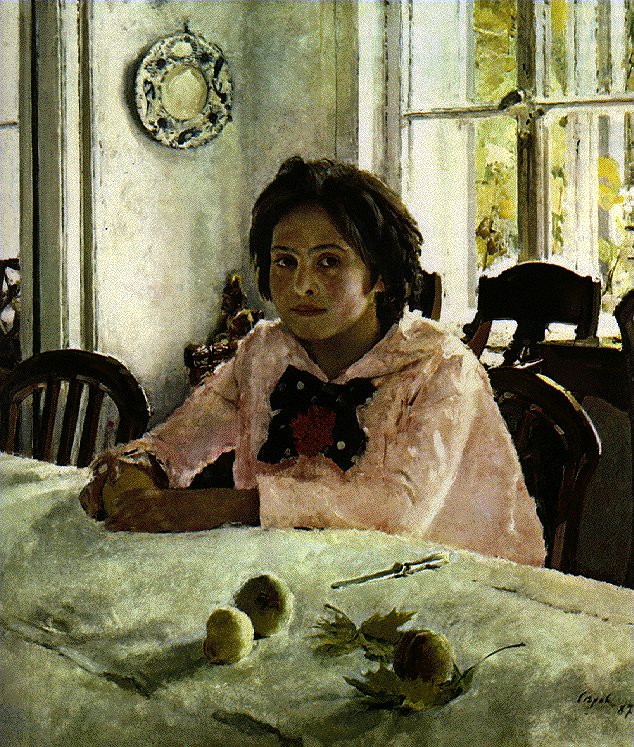 tudent 2: My favourite picture is the Girl with Peaches by Valentin Serov. He was born in 1865. His father was a well-known composer and the boy grew up in the atmosphere of creative activity. His first art teacher was Repin, who noticed that the boy could catch the likeness of a model often more quickly and surely than other artists. Later Serov studied at the Academy of Fine Arts and graduated from it when he was 20. For several years he taught at Moscow School of Painting Sculpture and Architecture. He painted almost 700 canvases, though, unfortunately his life was not very long - he died in 1911. He was a brilliant landscape painter, he created genre scenes, but he is mostly remembered as a portraitist. The list of his portraits reads as "who-is-who" in Russian culture of the late 19th and early 20th centuries. He painted Savva Mamontov, Konstantin Korovin, Ilya Repin, Isaak Levitan, Nikolai Lescov and others. And practically all his portraits are excellent from the technical point of view - the colours, the composition, but there is more than that - they show people's personality. Even though the portraits account for at least 80% of Serov's works, he also painted landscapes, for instance Autumn evening (1886), Pine Trees (1890), Autumn (1892), October (1895), and Haystacks (1901), genre scenes: Woman in a Cart (1896), In the Winter (1898), Woman with a Horse (1898), historical canvases devoted to Peter the Great: Young Peter Hunting with Dogs (1902), Peter the First (1907), Elizabeth Departing on a Hunt (1912), Peter the Great at the Work Site (1910-11), Peter in Monplaisir (1911), illustrations to Krylov's fables. The Girl with Peaches is the portrait of Vera Mamontova. The painting seems quite ordinary, but one can notice the play of light and shade in the picture. We can feel the atmosphere of a sunny summer day. The picture is full of life and joy. I like looking at it when I feel sad as it makes me forget about my problems.
tudent 2: My favourite picture is the Girl with Peaches by Valentin Serov. He was born in 1865. His father was a well-known composer and the boy grew up in the atmosphere of creative activity. His first art teacher was Repin, who noticed that the boy could catch the likeness of a model often more quickly and surely than other artists. Later Serov studied at the Academy of Fine Arts and graduated from it when he was 20. For several years he taught at Moscow School of Painting Sculpture and Architecture. He painted almost 700 canvases, though, unfortunately his life was not very long - he died in 1911. He was a brilliant landscape painter, he created genre scenes, but he is mostly remembered as a portraitist. The list of his portraits reads as "who-is-who" in Russian culture of the late 19th and early 20th centuries. He painted Savva Mamontov, Konstantin Korovin, Ilya Repin, Isaak Levitan, Nikolai Lescov and others. And practically all his portraits are excellent from the technical point of view - the colours, the composition, but there is more than that - they show people's personality. Even though the portraits account for at least 80% of Serov's works, he also painted landscapes, for instance Autumn evening (1886), Pine Trees (1890), Autumn (1892), October (1895), and Haystacks (1901), genre scenes: Woman in a Cart (1896), In the Winter (1898), Woman with a Horse (1898), historical canvases devoted to Peter the Great: Young Peter Hunting with Dogs (1902), Peter the First (1907), Elizabeth Departing on a Hunt (1912), Peter the Great at the Work Site (1910-11), Peter in Monplaisir (1911), illustrations to Krylov's fables. The Girl with Peaches is the portrait of Vera Mamontova. The painting seems quite ordinary, but one can notice the play of light and shade in the picture. We can feel the atmosphere of a sunny summer day. The picture is full of life and joy. I like looking at it when I feel sad as it makes me forget about my problems.
S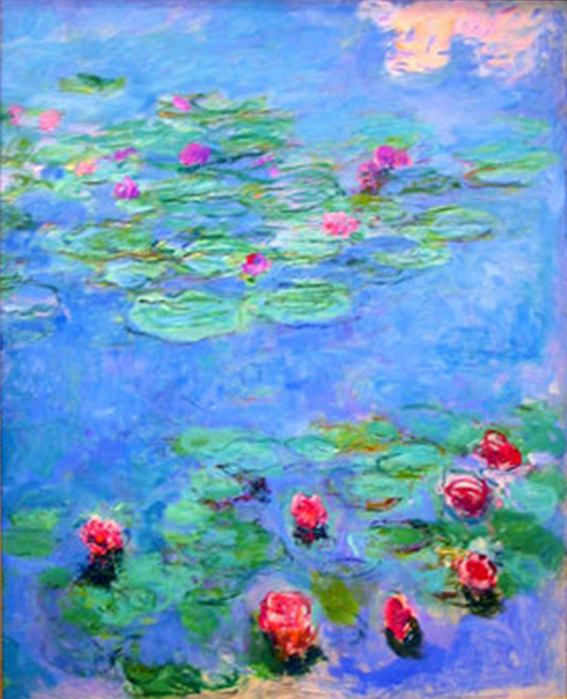 tudent 3: I like the paintings by Monet and one of my favourites is WaterLilies. As an Impressionist, Monet's canvases were painted spontaneously. In fact, Monet studied his subjects intently, planned his paintings, and worked hard to achieve his results. He often painted a series of the same subject to capture the changing effects of the light, swapping canvases as the day progressed. Monet used quite a limited palette, banishing browns and earth colors and, by 1886, black had also disappeared. Water Lilies is in the collection of the Fine Arts Museums of San Francisco. Monet is perhaps the most famous of the Impressionists, especially for his paintings of the reflections in the lily pond at his Giverny garden. This particular painting, shows a tiny bit of cloud in the top right-hand corner, and the mottled blues of the sky as reflected in the water. If you study photos of Monet's garden, such as this one of Monet's lily pond and this one of lily flowers, and compare them to this painting, you'll get a feeling for how Monet reduced detail in his painting, including only the essence of the seen, or the impression of the reflection, water, and lily flower. The French poet Paul Claudel said: "Thanks to water, Monet has become the painter of what we cannot see. He addresses that invisible spiritual surface that separates light from reflection. Airy azure captive of liquid azure ... Color rises from the bottom of the water in clouds, in whirlpools."
tudent 3: I like the paintings by Monet and one of my favourites is WaterLilies. As an Impressionist, Monet's canvases were painted spontaneously. In fact, Monet studied his subjects intently, planned his paintings, and worked hard to achieve his results. He often painted a series of the same subject to capture the changing effects of the light, swapping canvases as the day progressed. Monet used quite a limited palette, banishing browns and earth colors and, by 1886, black had also disappeared. Water Lilies is in the collection of the Fine Arts Museums of San Francisco. Monet is perhaps the most famous of the Impressionists, especially for his paintings of the reflections in the lily pond at his Giverny garden. This particular painting, shows a tiny bit of cloud in the top right-hand corner, and the mottled blues of the sky as reflected in the water. If you study photos of Monet's garden, such as this one of Monet's lily pond and this one of lily flowers, and compare them to this painting, you'll get a feeling for how Monet reduced detail in his painting, including only the essence of the seen, or the impression of the reflection, water, and lily flower. The French poet Paul Claudel said: "Thanks to water, Monet has become the painter of what we cannot see. He addresses that invisible spiritual surface that separates light from reflection. Airy azure captive of liquid azure ... Color rises from the bottom of the water in clouds, in whirlpools."
2. Викторина 'Are You an Expert in Painting?'
Teacher: And now we are going to have a short quiz on painting to test your knowledge in this field. Your task is to read the question and to choose the right answer. Let's start.
1. A famous English artist who painted "The Blue Boy".
A. Sir Joshua Reynolds B. Thomas Gainsborough C. J. M. W. Turner
2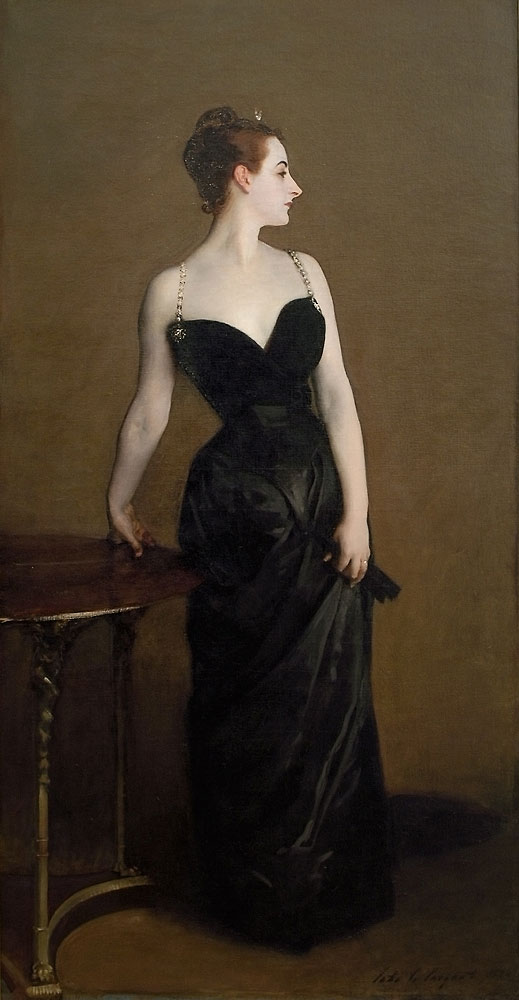 . What is the title of this painting by John Singer Sargent?
. What is the title of this painting by John Singer Sargent?
A. "Madame Montpellier" B. "Mrs. Smith" C. "Madame X"
3. Where can you see "Mona Lisa" by Leonardo da Vinci?
A. in the Tretyakov Gallery B. in the Louvre C. In the British Museum
4. Who painted "Girl on a Ball"?
A. Pablo Picasso B. Vincent Van Gogh C. Titian
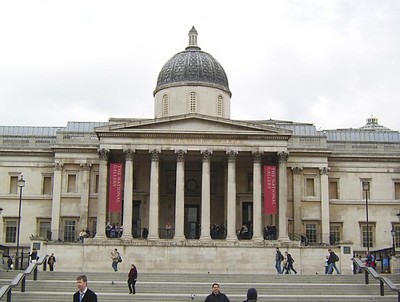
5. What is represented in the picture?
A. the Pushkin Museum of Fine Art B. the National Galley C. Freer Gallery of Arts
6. Where is Tate Gallery?
A . in London B. in Paris C. In New York
. in London B. in Paris C. In New York
7. What is the title of this painting by Brulov?
A. "The End of the World" B. "Judgement Day" C. "The Last Day of Pompeii"
8. How do we call a picture representing an arrangement of objects, especially flowers and fruit?
A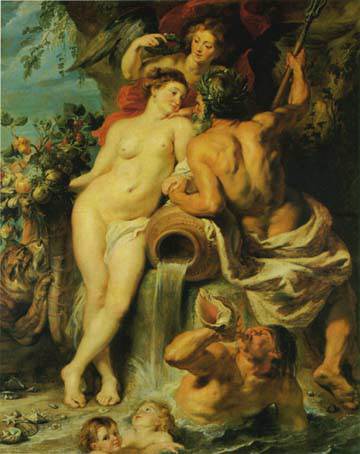 . portrait B. landscape C. still life
. portrait B. landscape C. still life
9. What is the title of this painting by Peter Paul Rubens?
A. "The Union of Earth and Water" B. "The Harmony of Earth and Water" C. "The Beauty of Earth and Water"
10. Where can you see "Madonna and Child" by Leonardo da Vinci?
A. in the Hermitage B. in the British Museum C. in the Louvre
ANSWERS.
(1.B 2.C 3.B 4.A 5.B 6.A 7.C 8. C 9.A 10.A)
3. Аудирование.
Teacher: And now listen to the dialogue and try to understand it. Say where the action takes place and what paintings the visitor would like to see.
-
Can I help you? I see you are in a difficulty.
-
Yes, thank you. You see, this is my first visit to the Hermitage.
-
Oh, I am sure you will enjoy seeing our collections. Only one visit here is not enough. You will have to come here again and again to get a full impression of the museum.
-
Of course, I understand that. I know that the Hermitage is one of the richest art museums of the world, and I cannot hope to see everything in one day.
A. What is it you would like to see today?
B. Do you have paintings by Renaissance masters?
A. Yes, we have a fine collection of their paintings on the second floor. Just go up this staircase, then walk along the corridor and cross the hall of the 19th century masters.
B. Thank you very much. Just one more question. Where are the English paintings?
A. Our collection of English paintings is rather small but very exquisite. You will find there a number of real masterpieces of world art.
B. Yes, I've heard about it and I am anxious to see your collection.
A. I am sure you won't be disappointed.
B. Thank you.
Teacher: Have you ever been to the Hermitage? Share your impressions with your group mates.
Student 4: When I was in St. Petersburg last summer I visited the Hermitage. I agree that the Hermitage is one of the richest art museums of the world and that only one visit there is not enough. There are more than 3, 000, 000 items in the Hermitage collections. Best of all I liked the collection of impressionist paintings.
Student 5: When I visited the Hermitage I liked The Treasure Gallery which consists of two sections: the Gold Rooms and the Diamond Rooms. The Gold Rooms has works from Eurasia, the Black Sea Littoral in antiquity, and the Orient. The Diamond Rooms shows the development of the jeweler's craft from the third millennium B.C. to the start of the 20th century.
Student 6: I liked the collection of Western European. Of course I didn't see all the paintings as the collection occupies 120 rooms in the four museum buildings. It includes numerous works by outstanding masters from Italy, Spain, Holland, Flanders, France, England, Germany, and other Western European countries.
4. Работа с текстом.
Teacher: And now your task will be to read the text about a famous painting by a well-known English artist Thomas Gainsborough and to put in the missing words.
"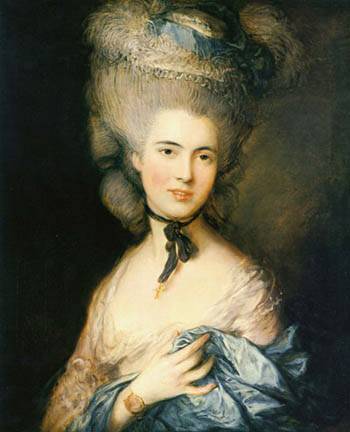 Portrait of Duchess Beaufort".
Portrait of Duchess Beaufort".
Thomas Gainsborough (1727-1788) was an (1) … English painter. He was a brilliant (2) … The artist's deep psychological (3) … enabled him to impart a poetic (4) … of the individuality. Gainsborough's "Portrait of Duchess Beaufort" is an outstanding (5) …The artist (6) … a graceful and attractive young woman. Her rather pale complexion is contrasted by the dark colour of the (7) … The artist (8) … the face by a little colour on her cheeks. Her greyish hair is combed very high and fastened with a comb and a blue ribbon, as was (9) … in those days. The portrait is painted in (10) … colours (black, blue, grey, white). The woman's parted lips, (11) … glance and graceful gesture of her hand help to create a true impression of the sitter's (12) … and optimism.
-
work of art, outstanding, depicts, expression, fashion, portraitist, fleeting, vitality, background, cold, approach, enlivens
Teacher: And what do you think of this picture?
Student 7: As for me, I like this portrait very much. The woman depicted by Thomas Gainsborough is very beautiful and she is dressed tastefully and according to the fashion of the day. She has a very pleasant face and patrician features. When you look at her, it seems that she is alive. Besides I like the colour scheme of the portrait as it is pleasant to my eyes.
Student 8: I like this painting very much. It is an outstanding work of art. Best of all I like the poetical mood of the picture and the restful tints. To my mind the duchess is a coquette and a woman of fashion. And I suppose that she is a bit light-minded and frivolous.
5. Работа с кроссвордом.
Teacher: And now I offer you to solve the crossword in order to remember some key-words on the theme "Painting".

Across.
1. Someone who produces art, especially paintings or drawings.
4. The area that is behind the main thing in a picture.
5. A picture showing an area of countryside or land.
6. A painting of a person.
7. An object that you use for painting, made with a lot of hairs, bristles, or thin pieces of plastic fastened to a handle.
9. A painting done with oil paints, or the piece of cloth it is painted on.
10. A small amount of a particular colour.
11. A work of art that is of very high quality or that is the best that a particular artist has produced.
Down.
2. Someone who uses impressionism in his paintings.
3. A large building where people can see famous pieces of art.
8. Someone who sits or stands while someone else paints them.
12. A wooden frame that you put a painting on while you paint it.
ANSWERS.
Across. 1. artist 4. background 5. landscape 6. portrait 7. brush 9. canvas 10. tint 11. masterpiece
Down. 2. impressionist 3. gallery 8. sitter 12. easel
6. Заключение.
Teacher: And at last I want you to comment on the epigraph: "A picture is a poem without words." (Horace)
Student 9: A great artist is like a writer who tells us an interesting story. But instead of words he uses a canvas, a brush and paints. The pictures of talented artists can really "speak" with the help of a sitter's facial expression, his posture and his background.
Student 10: Pictures teach you to understand life better, show people's true feelings and make you love them. Through their pictures artists tell us about their thoughts and feelings and open their inner world to us.
Teacher: I hope you enjoyed our lesson. Thank you for taking an active part in the discussion. Good Bye!


